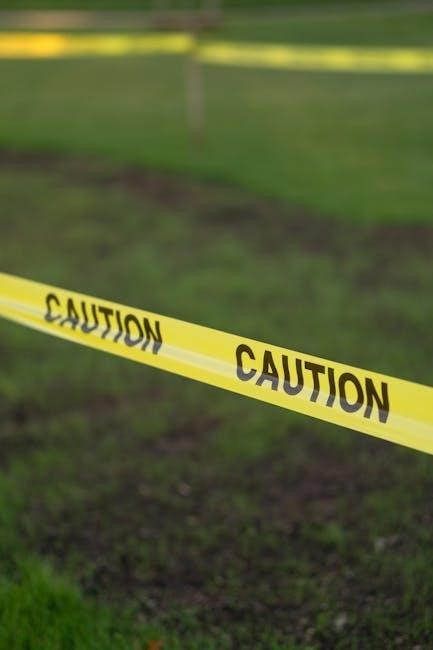Area and perimeter PDF worksheets are widely available on platforms like Math Salamanders, White Rose Maths, and Spectrum Math, offering comprehensive practice for various shapes and skill levels.
1.1 What Are Area and Perimeter Worksheets?
Area and perimeter worksheets are educational resources designed to help students practice calculating the area and perimeter of various shapes. These worksheets typically include problems involving squares, rectangles, triangles, and complex figures, with measurements provided for calculations. Many worksheets, such as those from Math Salamanders and White Rose Maths, are available in PDF format, offering convenience and portability. They often include answer keys and step-by-step guides to assist students in understanding the concepts. These tools are ideal for both classroom use and independent practice, catering to different skill levels and learning needs.
1.2 Importance of Using PDF Worksheets for Math Practice
PDF worksheets are a valuable tool for math practice, offering convenience, portability, and cost-effectiveness. They can be easily downloaded, printed, and shared, making them accessible for students and educators alike. PDFs are also environmentally friendly compared to traditional paper-based resources. Additionally, they often include answer keys and detailed solutions, providing immediate feedback and enhancing learning. Platforms like Math Salamanders and Spectrum Math offer a wide range of grade-specific PDF worksheets, ensuring that students can practice area and perimeter calculations at their own pace and skill level.

Key Concepts of Area and Perimeter
Area measures the space inside a shape, while perimeter measures the total length around it. Both concepts use specific formulas to calculate values for various shapes like rectangles and triangles.
2.1 Understanding Area: Definition and Formula
The area of a shape is the measure of the space inside it, expressed in square units. For rectangles and squares, the area is calculated by multiplying length by width. The formula for the area of a rectangle is Area = length × width. For a square, since all sides are equal, the area is Area = side². These formulas are essential for solving problems involving various shapes and are widely used in educational PDF worksheets to help students master area calculations.
2.2 Understanding Perimeter: Definition and Formula
The perimeter of a shape is the total length around its outer edges. For rectangles and squares, it is calculated by adding all side lengths. The formula for the perimeter of a rectangle is Perimeter = 2 × (length + width), while for a square, it simplifies to Perimeter = 4 × side. For triangles, the perimeter is the sum of all three sides. Understanding these formulas is crucial for solving problems in area and perimeter PDF worksheets, which often include exercises for various shapes, including circles, where the perimeter is referred to as the circumference.
2.3 Differences Between Area and Perimeter
The area of a shape measures the space inside it, expressed in square units, while the perimeter measures the total length around the shape, expressed in linear units. Area calculates the interior space, often using formulas like Area = length × width for rectangles, while perimeter sums the outer edges, using formulas like Perimeter = 2 × (length + width). These concepts are fundamental in geometry and are extensively practiced in area and perimeter PDF worksheets to develop spatial understanding and mathematical accuracy.

Types of Shapes Covered in Worksheets
Area and perimeter PDF worksheets cover various shapes, including rectangles, squares, triangles, circles, and complex figures, providing comprehensive practice for different geometric concepts and skill levels.
3.1 Rectangles: Calculating Area and Perimeter
Rectangles are a fundamental shape in area and perimeter worksheets, with problems involving various measurements. The area of a rectangle is calculated as length × width, while the perimeter is 2 × (length + width). Worksheets often include scenarios requiring students to find missing dimensions or compare areas and perimeters of different rectangles. These exercises help students understand spatial relationships and apply mathematical formulas to real-world problems, such as room layouts or fencing calculations. PDF resources make these exercises easily accessible and printable for practice and review.
3.2 Squares: Special Cases of Rectangles
Squares are special cases of rectangles where all sides are equal. Calculating the area and perimeter of squares is straightforward, with the area being side length squared and the perimeter being four times the side length. Worksheets often include squares to simplify calculations and introduce students to basic area and perimeter concepts. These exercises help build foundational math skills and prepare students for more complex shapes. PDF resources provide numerous square-based problems, making practice convenient and accessible for learners of all levels.
3.3 Triangles: Area and Perimeter Calculations
Triangles are three-sided polygons with varying side lengths and angles. Calculating their area requires the base and height, while the perimeter is the sum of all sides. Worksheets often include equilateral, isosceles, and scalene triangles to practice these calculations. For equilateral triangles, all sides are equal, simplifying perimeter and area calculations. PDF resources, such as those from Math Salamanders and Spectrum Math, provide numerous triangle-based problems to help students master these concepts through structured practice exercises and real-world applications.
3.4 Circles: Area and Circumference (Perimeter Equivalent)
Circles introduce the concept of circumference, the perimeter equivalent, and area calculation using radius or diameter. The area of a circle is calculated using the formula πr², while the circumference is 2πr or πd. Worksheets often include problems involving circles, such as finding the area given the radius or calculating the circumference for real-world objects like wheels or ponds. Resources like Math Salamanders and Spectrum Math provide detailed PDF exercises to help students grasp these circular measurements through practical examples and step-by-step solutions.
3.5 Complex Shapes: Combining Rectangles and Triangles
Complex shapes, such as L-shapes or composite figures, require breaking the shape into simpler rectangles and triangles to calculate area and perimeter. Worksheets often include exercises where students divide irregular shapes into familiar forms, summing their areas or adding perimeters while accounting for shared sides. This approach enhances spatial reasoning and problem-solving skills. Resources like Math Salamanders and Spectrum Math provide detailed PDF exercises for practicing these calculations, ensuring mastery of area and perimeter for mixed and compound figures.
- Emphasizes breaking complex shapes into simpler components.
- Helps improve spatial reasoning and mathematical accuracy.

Benefits of Using PDF Worksheets
PDF worksheets offer convenience, portability, and cost-effectiveness, making math practice accessible anytime, anywhere. They are easy to print, share, and store, reducing paper waste and saving time.
- Convenient and portable for anytime practice.
- Cost-effective and environmentally friendly.
- Easy to print and distribute.
4.1 Convenience and Portability
Area and perimeter PDF worksheets provide unmatched convenience and portability. They are easily accessible on multiple devices, eliminating the need for physical books. Students can practice anywhere, whether at home, school, or on the go. PDFs are lightweight and can be stored on tablets, laptops, or smartphones, making them ideal for modern learning. This portability ensures that practice materials are always within reach, fostering consistent learning and better retention of math concepts. The flexibility of PDFs enhances the overall learning experience, catering to diverse student needs and preferences.
- Accessible on multiple devices.
- Lightweight and easy to store.
- Perfect for learning on the go.
4.2 Cost-Effective and Environmentally Friendly
Area and perimeter PDF worksheets are a cost-effective and eco-friendly alternative to traditional workbooks. They eliminate the need for expensive textbooks, offering free or low-cost resources accessible to everyone. By reducing paper usage, PDFs help conserve resources and minimize environmental impact. Many websites provide free downloadable worksheets, making high-quality math practice affordable and sustainable. This approach aligns with eco-conscious learning, ensuring that students can practice without contributing to deforestation or waste. It’s a practical and responsible way to support both education and the planet.
- Free or low-cost resources available online.
- Reduces paper usage and environmental impact.
- Sustainable alternative to traditional workbooks.

4.3 Easy to Print and Distribute

Area and perimeter PDF worksheets are incredibly easy to print and distribute, making them ideal for classrooms and home use. Teachers can print multiple copies quickly, ensuring every student has access to practice materials. PDFs maintain high-quality formatting across devices, guaranteeing clear and readable content. Additionally, they can be easily shared via email or learning platforms, saving time and effort. This convenience ensures that students can focus on learning without delays, making PDF worksheets a practical choice for educators and parents alike.
- Quick and high-quality printing.
- Easy sharing via digital platforms.
- Consistent formatting across devices.

How to Solve Area and Perimeter Problems
To solve area and perimeter problems, identify the shape, measure its sides, apply the correct formula, and calculate the result. Ensure units are consistent for accurate outcomes.
5.1 Step-by-Step Approach to Calculations
Start by identifying the shape and its dimensions. For rectangles, use length and width; for triangles, base and height. Apply the correct formula: area = length × width for rectangles or (base × height) / 2 for triangles. For circles, use πr² for area and 2πr for circumference. Double-check units to ensure consistency. Sketching the shape can help visualize the problem. Calculate step-by-step, ensuring accuracy in each part of the process. Verify your results by rechecking measurements and formulas.
5.2 Using Formulas Correctly
Mastering formulas is essential for accurate area and perimeter calculations. For rectangles, area = length × width and perimeter = 2 × (length + width). For triangles, area = (base × height) / 2, while perimeter is the sum of all sides. Circles use πr² for area and 2πr for circumference. Ensure units are consistent and formulas are applied to the correct shapes. Double-check calculations to avoid errors. Practice labeling sides and organizing work to maintain clarity and accuracy when solving problems.
5.3 Tips for Avoiding Common Mistakes
Common errors in area and perimeter problems often stem from unit inconsistencies or formula misapplication. Always ensure measurements are in the same unit before calculations. Double-check formulas for the correct shape, as using the wrong one leads to incorrect results. For circles, remember to use π for circumference. Label diagrams clearly and show step-by-step work to avoid confusion. Verify calculations for arithmetic errors, especially when squaring or multiplying numbers. Organized work helps minimize mistakes and ensures accuracy in solving problems effectively.
Popular Resources for Area and Perimeter Worksheets
Math Salamanders, White Rose Maths, and Spectrum Math offer comprehensive PDF worksheets, covering various shapes and skill levels for effective area and perimeter practice.
6.1 Math Salamanders: Comprehensive Worksheets
Math Salamanders offers an extensive collection of area and perimeter PDF worksheets, designed for various skill levels and shapes. Their resources include detailed guides and practice sheets for rectangles, squares, triangles, and complex shapes. Worksheets are accompanied by answer keys, making them ideal for self-study and homework. With a focus on clarity and progression, Math Salamanders caters to students of all ages, providing a robust foundation for mastering area and perimeter calculations. Their materials are widely praised for their simplicity and effectiveness.
6.2 White Rose Maths: KS2 Worksheets
White Rose Maths provides high-quality KS2 worksheets tailored for Year 3 students, focusing on calculating perimeters of 2D shapes. These resources emphasize foundational skills, offering clear instructions and engaging exercises. The worksheets are designed to align with curriculum standards, ensuring a structured learning experience. Perfect for classroom use or independent practice, they help build confidence in area and perimeter calculations. Their user-friendly format and step-by-step approach make them a valuable tool for both teachers and students.
6.3 Spectrum Math: Grade-Specific Worksheets
Spectrum Math offers grade-specific worksheets, such as those for Grade 8, focusing on perimeter, area, and volume calculations. These PDF resources include detailed lessons, like finding the area of a triangle or calculating perimeters of various shapes. The worksheets are designed to align with curriculum standards, ensuring comprehensive coverage of math skills. With clear instructions and practice problems, Spectrum Math provides a structured approach to mastering area and perimeter concepts, making it a reliable choice for educators and students alike.
Advanced Topics in Area and Perimeter
Advanced topics include word problems, mixed shapes, and compound figures, applying area and perimeter calculations to real-world scenarios.

7.1 Word Problems Involving Area and Perimeter
Word problems challenge students to apply area and perimeter concepts to real-life scenarios, such as calculating fencing for a garden or material for a room. These problems often involve mixed shapes, requiring students to break down complex figures into simpler components. Worksheets like those from Math Salamanders and Spectrum Math offer a variety of word problems, including calculating the perimeter of a square garden or the area of a triangular roof. Such exercises enhance critical thinking and practical application skills, making math more engaging and relevant. They also encourage students to visualize shapes and interpret measurements effectively.
7.2 Mixed Shapes and Compound Figures
Mixed shapes and compound figures combine basic forms like rectangles, triangles, and circles, requiring students to break them into simpler parts for calculations. These problems enhance spatial reasoning and problem-solving skills, as seen in worksheets from Math Salamanders and Spectrum Math. They often involve calculating the total area or perimeter by summing individual components, making them more challenging and engaging. Such exercises prepare students for real-world applications and more complex geometric concepts, fostering a deeper understanding of area and perimeter relationships in diverse configurations.
7.3 Real-World Applications of Area and Perimeter
Understanding area and perimeter is crucial for real-world applications, such as construction planning, landscaping, and crafting. For instance, calculating the area helps determine material requirements, while perimeter measurements are essential for fencing or flooring. These concepts are also vital in design fields, enabling precise measurements for projects like room layouts or fabric patterns. PDF worksheets provide practical exercises that mirror these scenarios, helping students apply mathematical skills to everyday problems and professions, making learning more relevant and engaging. This connection fosters a deeper appreciation for geometry in real-life contexts.
Area and perimeter PDF worksheets offer an engaging and practical way to master geometry skills, providing clear benefits for learners at all educational levels and interests.
8.1 Summary of Key Takeaways
Area and perimeter PDF worksheets are essential tools for mastering geometry, offering comprehensive practice across various shapes and skill levels. They provide clear formulas, step-by-step calculations, and real-world applications, enhancing problem-solving skills. Resources like Math Salamanders, White Rose Maths, and Spectrum Math offer diverse worksheets, from basic to complex shapes, ensuring a thorough understanding. These PDFs are convenient, printable, and ideal for independent or classroom use, making them invaluable for learners seeking to excel in area and perimeter calculations.
8.2 Encouragement to Practice Regularly
Regular practice with area and perimeter PDF worksheets is crucial for building a strong foundation in geometry. Consistent practice helps reinforce concepts, improves problem-solving skills, and boosts confidence. Start with basic shapes like rectangles and squares, then gradually move to triangles, circles, and complex figures. Utilize resources from Math Salamanders, White Rose Maths, and Spectrum Math for varied exercises. Encourage learners to set aside time daily to solve problems, ensuring steady progress and mastery of these essential math skills.

Frequently Asked Questions (FAQs)
Where can I find free PDF worksheets? Free area and perimeter PDF worksheets are available on platforms like Math Salamanders, White Rose Maths, and Spectrum Math.
How do I choose the right worksheet? Select worksheets based on your skill level or grade, ensuring they cover the shapes and concepts you need to practice.
Can I customize worksheets? Some resources allow customization, but many worksheets are pre-designed for specific needs and skill levels.
9.1 Where Can I Find Free PDF Worksheets?
Free area and perimeter PDF worksheets are available on educational websites like Math Salamanders, White Rose Maths, and Spectrum Math. These platforms offer a wide range of worksheets tailored to different grade levels and math skills. You can download and print them easily, making them ideal for homework, classroom activities, or self-study. Many of these resources include answer keys, ensuring you can check your progress and understand the solutions. They cover various shapes, from basic rectangles and triangles to more complex figures, providing comprehensive practice for mastering area and perimeter calculations.
9.2 How Do I Choose the Right Worksheet for My Level?
To choose the right area and perimeter worksheet, consider your skill level and the specific math concepts you need to practice. Worksheets are often categorized by grade or difficulty, such as Grade 5 or KS2. Look for resources that match your current understanding, whether you’re focusing on basic shapes or advanced problems. Websites like Math Salamanders and Spectrum Math offer grade-specific options, while White Rose Maths provides KS2-level materials. Ensure the worksheet includes answer keys for self-assessment and covers the shapes and calculations you need to master.
9.3 Can I Customize the Worksheets for Specific Needs?
Many PDF worksheets can be customized to suit specific needs, such as focusing on particular shapes or difficulty levels. Teachers and parents can often edit the content or select specific problems from larger sets. Some resources, like those from Math Salamanders and K5 Learning, provide customizable templates. Additionally, tools like PDF editors allow users to modify existing worksheets, ensuring they align with individual learning objectives. This flexibility makes it easier to tailor practice sessions for different learners or educational goals.